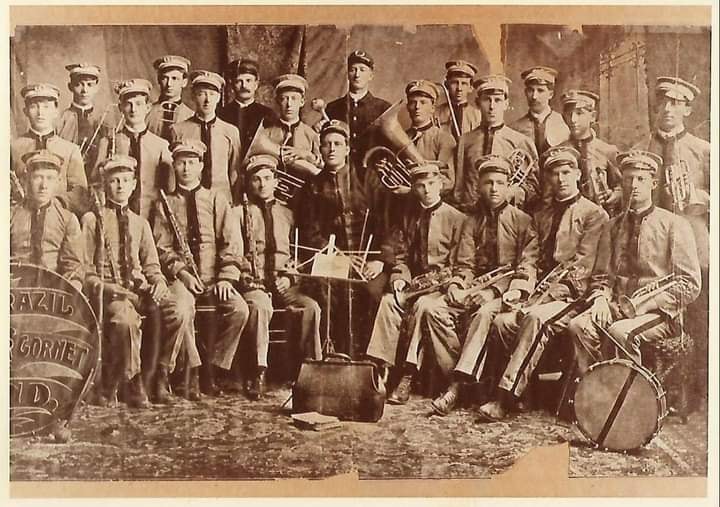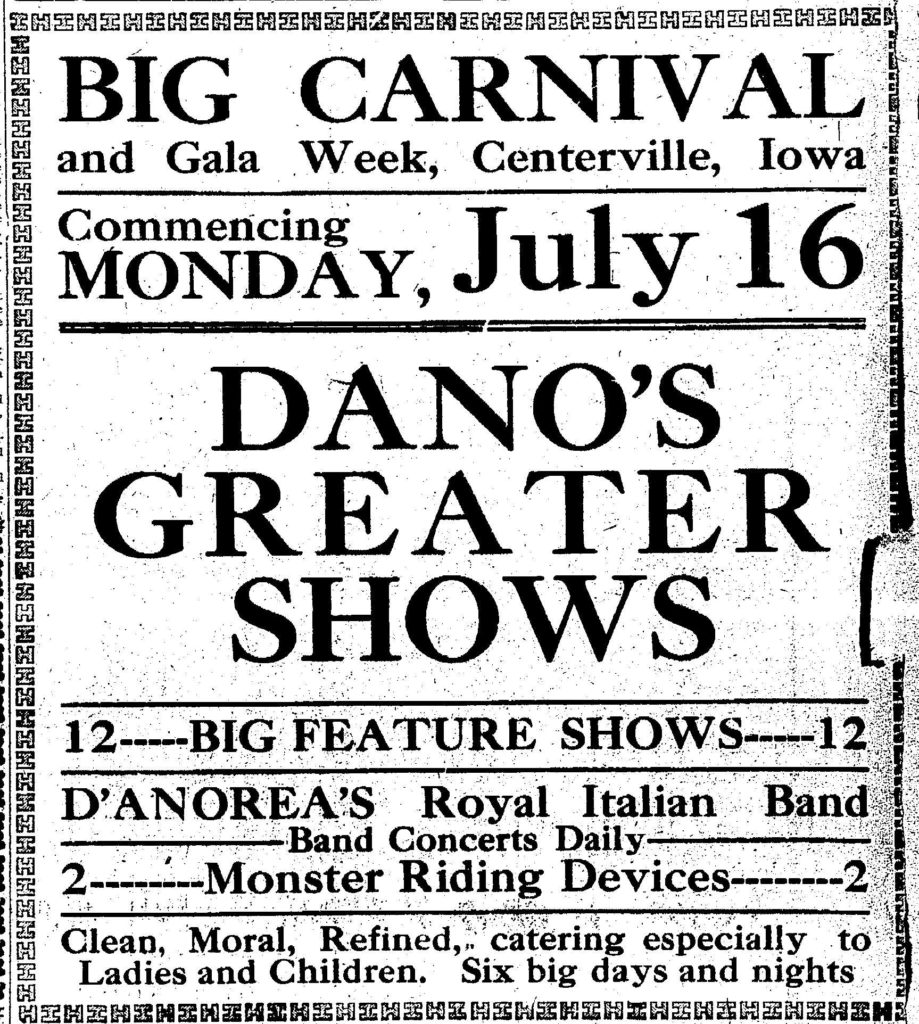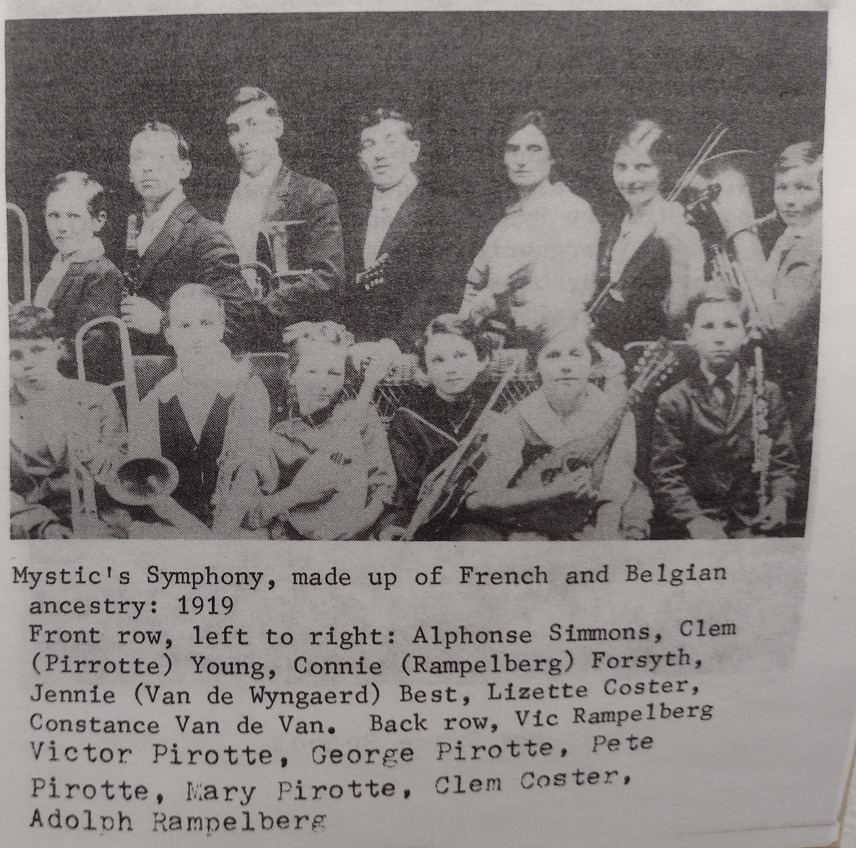I shared a photo of my grandmother Eveline Coates’ high school graduating class in Mystic, Iowa a few weeks ago. Along with the photo and her diploma, a couple of other mementos were saved. One is the program for the Junior-Senior Banquet in honor of the graduating Seniors. It was interesting to see how World War I seemed to be the overarching theme of the festivities. I decided to take a deeper look at what her life may have been like during the 1917-1918 school year. There was a lot going on, a war and the beginning of an influenza pandemic to name the two biggies. See:
Eveline’s Senior Year, Part 1
Eveline’s Senior Year: The Draft and a Carnival
Eveline’s Senior Year: A Look Around Town

The town of Mystic, Iowa, where my grandmother Eveline Coates was born and raised, was a community that included many immigrants lured by the coal mining boom in the early 1900s. The 1910 census of Mystic details residents born in England, Scotland, France, Belgium, Italy, Germany, Wales, Canada. Poland, Austria, Sweden, Ireland, Denmark, Russia, Bulgaria, Turkey, and Cuba. A few of those countries were represented by only one resident – but certainly this was a diverse community given that the population in 1910 was 2,663. Eveline’s parents were members of the immigrant community as well, having been born in England.
I inquired about photos of the bands in Appanoose County in a Facebook group and was told that there is a photo of a Mystic Italian band. The poster promised to share it. I am waiting. That would have been the perfect match to the prompt photo. Oh well…
The nearby town of Rathbun included a significant community from Croatia and had a Croatian band. I haven’t found a picture of that band either. Below is an undated photo of the band from nearby Brazil, Iowa.

The county seat was (and is) the town of Centerville, connected to Mystic by the Interurban. The Centerville band gave frequent concerts and the band also traveled to the smaller towns in the county to provide musical entertainment, often on special occasions. It is not unreasonable to wonder if Eveline might have gone to Centerville and heard the Centerville band perform or have taken in some other musical entertainment there.
Centerville was often the site of traveling carnivals, which seem to always have included a band that gave daily concerts. Dano’s Greater Shows featured an Italian band, the bandleader’s name misspelled in the advertisement that ran repeatedly in the newspaper. I think it should be D’Andrea or D’Andreas.

Eveline must have heard the Centerville Band perform in Mystic – during Memorial Day festivities, for example:
Maybe Eveline heard the Centerville Band at a fundraising gathering hosted by the Red Cross later that June.
Of course, most of the local high schools had bands and I can easily imagine that Eveline attended most of the events where the Mystic High School Band performed.
The booklet History of Mystic, Iowa 1887-1987 includes a photo of the Mystic Symphony (sometimes referred to in the newspaper as “Mystic’s little orchestra”).

The caption dates the photo as 1919 and provides the names of the members, who were of primarily French and Belgian ancestry. The symphony musicians appear to encompass a wide range of ages – from children to young adults. I think there is more than one family of Pirottes included, but I haven’t put in the work to verify my suspicions.
In 1916, a Victor Pierrotte, perhaps father of the Victor in the symphony photo, is reported to have leased space in the Lyric Theater to show movies and is described as “one of the band boys” who is willing to show up and play upon request.

Victor Joseph Pirotte and Victor Emile Pirotte became naturalized citizens in January of 1920, so perhaps this adds credence to my father/son theory. If that is the case, they were both “band boys.”
George Pirotte, standing next to Victor in the symphony photo, seems to have unwittingly lived without benefit of marriage vows for two years, possibly not having a clear understanding of the laws and customs of his adopted home. Oops!

Members of the Mystic Symphony shared their musical talents in a variety of settings. In April of 1917, Lizzie Coster, Clemetine Pirotte, Constance Van de Van, and Victor Pirotte, all performed as soloists or as part of a duet at a meeting of the Foresters of America – and were likely members of the school orchestra.

Newspaper clippings reveal connections between members of the symphony and my families – none specifically to Eveline, but to her siblings, her future husband, his sister, and probably some cousins. Also, one of the Pirotte families lived on a lot adjacent to Eveline’s family. Below, Eveline’s younger siblings Bernard and Blanche, were recognized for perfect attendance at school along with a Rampelberg, a Pirotte, and two Costers.
Eveline’s future husband, Thomas Hoskins, attended a party of the Junior Philatheas of the Christian Church, and so did Victor Pirotte.
Eveline’s younger sister Blanche and future sister-in-law Ethel Hoskins, attended normal school in Cedar Falls with Felicia Pirotte, and Lizzie and Clemence Coster. They travelled back home together for the holidays.


Looking into the musical ensembles and their members provides one more little glimpse into the life of my grandmother. I have never heard that Eveline played a musical instrument, but music was integral to her community and, by extension, to her. These school mates and classmates grew up together, had siblings who were friends, attended many of the same activities, and were simply well-known to one another. The diverse backgrounds among her friends and classmates would have greatly influenced Eveline’s experience of her town and shaped her outlook on the the world at large.
Visit others who have written and shared old photos in response to the prompt photo here: Sepia Saturday.
Sepia Saturday provides bloggers with an opportunity to share their history through the medium of photographs. Historical photographs of any age or kind become the launchpad for explorations of family history, local history and social history in fact or fiction, poetry or prose, words or further images. If you want to play along, sign up to the link, try to visit as many of the other participants as possible, and have fun.







I know this post focuses on the music surrounding your grandmother during her youth, but I laughed out loud at the story of George Pirotte and his wife not realizing they weren’t married! These are the stories of real-life foibles that genealogists dream about 🙂 That said, you’ve done an excellent job of making the friends-neighbors-associates connections (through music) that help illuminate your grandmother Eveline’s day-to-day life in Iowa.
Once I read this, I just had to include it. Poor George and Denise!
Well done! A wonderful story about how live music was once an integral part of American small town life. It mirrors much of what I’ve discovered in collecting musical photos and postcards from the Midwest. Immigrants, whether Irish, Italian, German, or Croatian always brought a love of music that became a part of their new American culture. Every church and fraternal society needed music for their respective rituals and each group organized its own band or orchestra to suit its needs. As communities competed for more settlers. more business, more industry, their musical ensembles became a way of promoting a town. Like sports in later generations, bands had a friendly rivalry and often hired a music director just like an athletic coach to improve the musicians. And since musical talent always attracted attention and praise, newspapers reported on concerts and events as a way to build their community and sell papers too. Sadly this all disappeared with the invention of radio, television, films, etc.
And what is a “Monster Riding Device”? I’d buy a ticket now just to see it.
I can’t believe I neglected to research the monster riding device! Another day, perhaps.